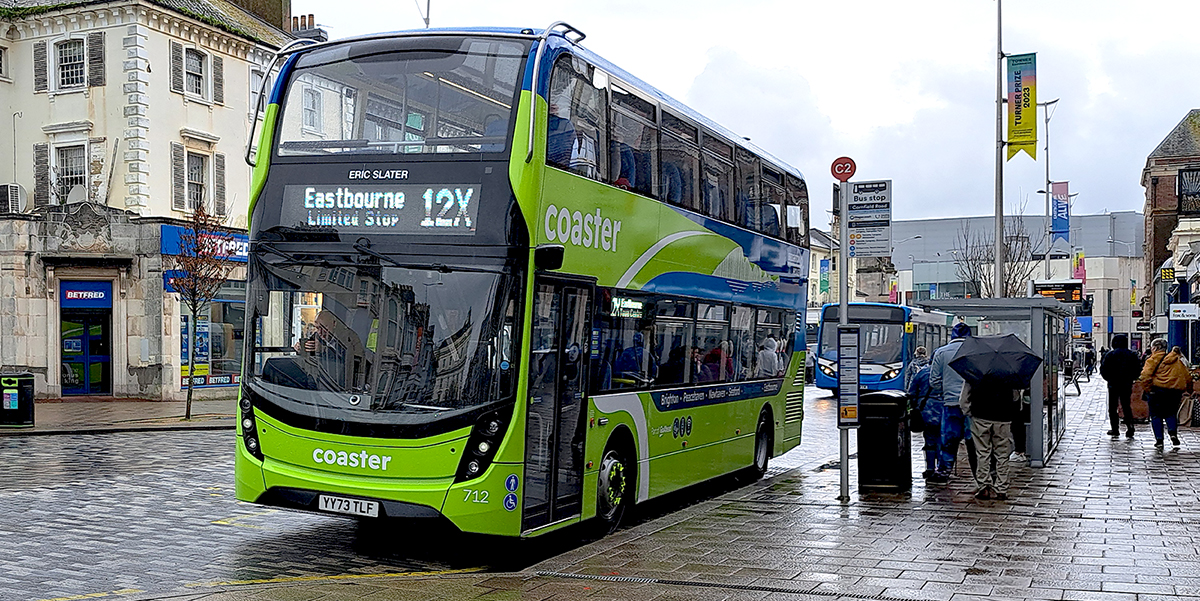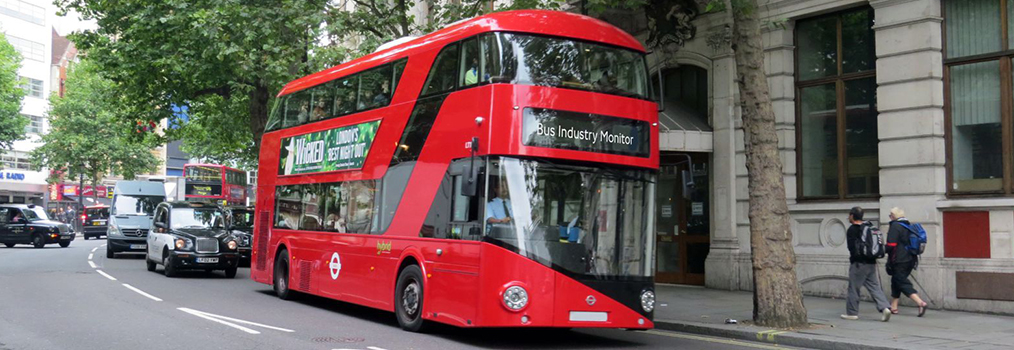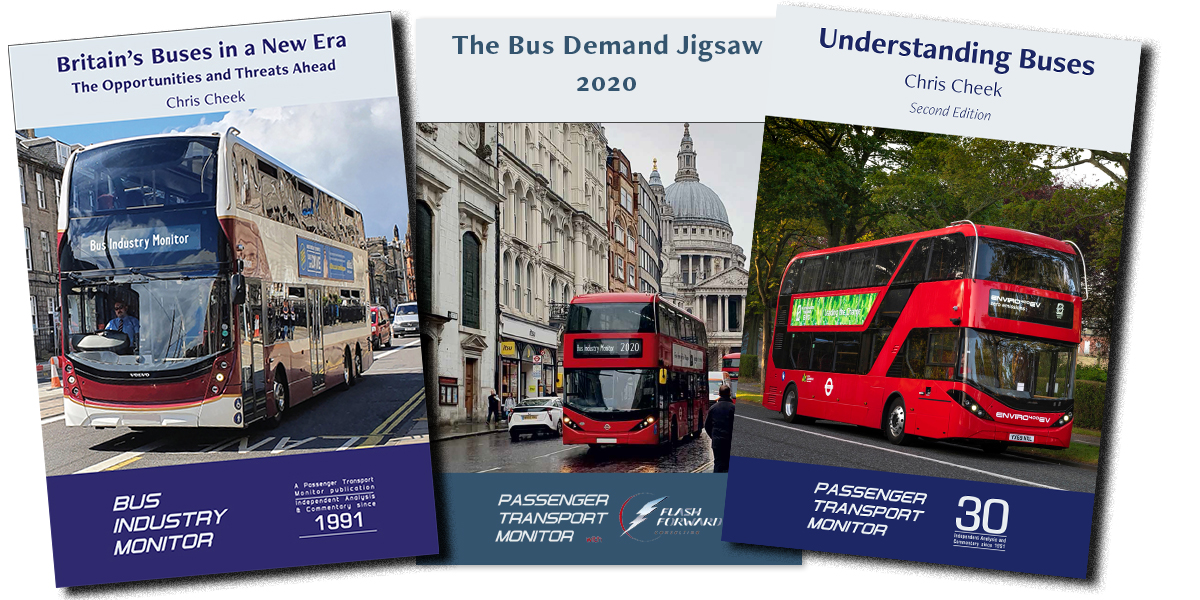NTS update confirms major shifts in bus trip making
Huge falls in trip rates amongst women and older people since Covid revealed in new figures
The Department for Transport (DfT) has published new data from its National Travel Survey†, combining data from the last six months of the 2022 survey with the first six of 2023. The limited number of tables predates publication of the full 2023 data later in the year.
The figures point to a continuing recovery from the Covid-19 pandemic, with overall trip rates increasing between the 2022 survey and these interim results. The public as a whole made an estimated 882 trips per person per year (tpppy) by all modes in 2022/23, up by 3.4% compared with 2022. However, the figure remained 8.2% below the 952.6 trips recorded in the 2019 survey.
Shopping trips, for long the backbone of travel demand, also increased, up 2.7% to 165.4 tpppy, compared with 2022’s figure of 151.1. Again, however, this was substantially down on pre-pandemic levels, when 180.6 tpppy were recorded. That’s a shortfall of 15.4%.
Looking specifically at the bus market in England outside London, the overall trip rate crept up by one per cent, with a rate of 23.5 tpppy compared with 23.2 in 2022. The last pre-Covid figure recorded in 2019 was 31.6, leaving a shortfall of 25.8%.
Analysis of responses on people’s reasons for making their journey, trip rates for commuting, business and education and leisure all fell slightly between 2022 and the latest data, whilst those for shopping, escorting and personal business showed an increase (see Figure 1). When comparing the 2022/23 trip rates with those of 2019, we see a sharp fall in all categories, ranging from 21% for commuting to 55% for business travel (albeit on a very low base – even in 2019, the rate was only 0.483 tpppy).
Translating those trip rates into estimated passenger numbers, we see from Figure 2 that there is now a roughly even split in percentage terms between commuting/business (22.5%), shopping (23.3%), education 23.2%) and leisure (20.7%) than in previous years. In the days before online retail took off, shopping tended to predominate, accounting for over 30% of trips in the first decade of the century.
Figure 1: Changes in Trip Rates by Journey Purpose
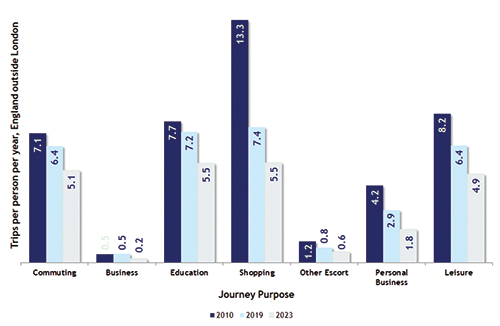
Figure 2: Shifts in the Market Share of Bus Trips by Journey Purpose
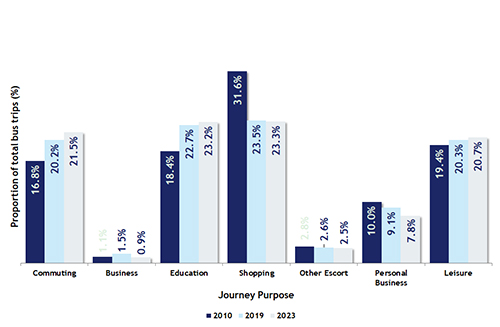
There have been some major shifts in the demographic profile of bus users, according to the survey, with trip rates falling across the generations, but particularly amongst older people (see table). The overall small recovery in 2022/23 was not universal: there were continuing falls in trip rates amongst those between 17 and 20, and people in their forties and fifties. The highest year-on-year growth came from those over 70, showing an increase of 14.6%.
Comparing trip rates with the last pre-pandemic year, one age-group, between 30 and 39, actually shows an improvement of 3.5%, but the others show sharp falls: this is as high as 42% amongst people in their sixties, and 34% amongst the over seventies. Young people under 17 show a 32% decline.
There are some significant differences in behaviour between men and women, with the latter showing much more significant falls in bus use since 2019 across all age groups, with the gap widening with age, so women in their sixties are making two-thirds fewer trips since the pandemic. Even so, women continue to have higher trip rates than men across all age groups save one, the twentysomethings.
Bus Trip Rates in England outside London by Age and Gender (trips per person per year)
| All ages | <17 | 17-20 | 21-29 | 30-39 | 40-49 | 50-59 | 60-69 | 70+ | |
| All People | |||||||||
| 2010 | 42.2 | 44.2 | 87.4 | 43.4 | 27.5 | 26.5 | 27.9 | 53.7 | 60.4 |
| 2019 | 31.6 | 36.5 | 73.3 | 33.0 | 19.9 | 18.5 | 20.9 | 30.7 | 46.4 |
| 2023 | 23.5 | 24.9 | 64.9 | 27.7 | 20.6 | 15.9 | 12.9 | 17.9 | 30.4 |
| Change since 2010 | (44.3%) | (43.6%) | (25.8%) | (36.2%) | (25.2%) | (39.9%) | (53.7%) | (66.7%) | (49.6%) |
| Change since 2019 | (25.8%) | (31.8%) | (11.5%) | (16.0%) | 3.5% | (14.0%) | (38.2%) | (41.9%) | (34.4%) |
| Males | |||||||||
| 2010 | 36.2 | 44.2 | 72.3 | 39.0 | 23.0 | 19.0 | 23.9 | 43.9 | 47.6 |
| 2019 | 27.0 | 36.1 | 68.9 | 34.0 | 13.1 | 9.8 | 16.9 | 21.8 | 39.3 |
| 2023 | 21.0 | 23.8 | 65.1 | 21.5 | 14.9 | 17.5 | 10.9 | 14.8 | 27.2 |
| Change since 2010 | (42.0%) | (46.3%) | (10.0%) | (44.9%) | (35.3%) | (8.3%) | (54.3%) | (66.2%) | (42.9%) |
| Change since 2019 | (22.3%) | (34.1%) | (5.5%) | (36.7%) | 14.1% | 78.9% | (35.1%) | (31.8%) | (30.8%) |
| Females | |||||||||
| 2010 | 48.0 | 57.9 | 126.7 | 53.4 | 34.5 | 39.5 | 39.4 | 65.4 | 75.5 |
| 2019 | 36.1 | 44.1 | 102.9 | 47.9 | 31.9 | 33.8 | 31.8 | 63.0 | 70.2 |
| 2023 | 25.9 | 26.1 | 64.7 | 33.6 | 25.9 | 14.4 | 14.8 | 20.8 | 33.2 |
| Change since 2010 | (46.1%) | (54.9%) | (48.9%) | (37.0%) | (24.9%) | (63.5%) | (62.3%) | (68.2%) | (56.0%) |
| Change since 2019 | (28.4%) | (40.8%) | (37.1%) | (29.8%) | (19.0%) | (57.3%) | (53.3%) | (67.0%) | (52.7%) |
† - The NTS is a household survey of personal travel, from data collected via interviews and a seven-day travel diary, which enables analysis of patterns and trends. The statistics for the year ending June 2023 include data from the second half of 2022 and the first half of 2023. In the year ending June 2023, the survey captured responses from 10,351 individuals covering 167,916 trips. The National Travel Survey mid-year estimates are available at https://www.gov.uk/government/statistics/national-travel-survey-mid-year-estimates-year-ending-june-2023.
